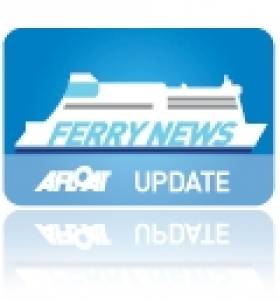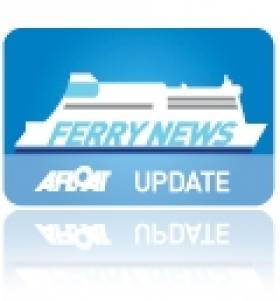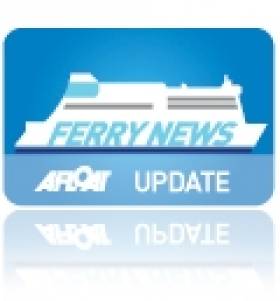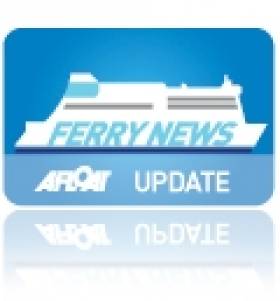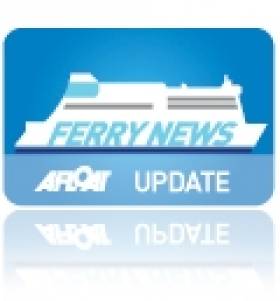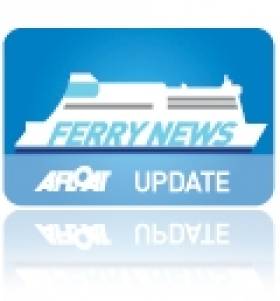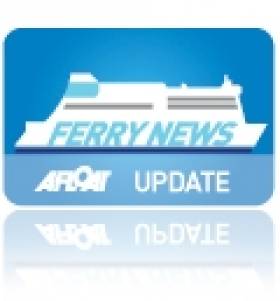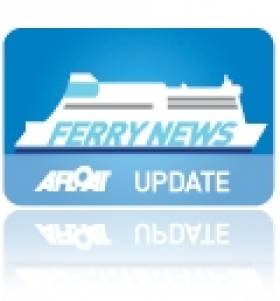Displaying items by tag: Stena Line
Stena's Dublin Route ‘Nordica’ to Transfer to Newcomer's Former Dover Role
#ShipsSwap – Stena Nordica is due to leave the Dublin-Holyhead route next month in a swap that sees replacement 'Superfast X' which as previously reported had served on the Straits of Dover, writes Jehan Ashmore.
Stena Line are to transfer the outgoing 'Nordica' (see related report) to DFDS Seaways Dover-Calais route from where the newcomer Stena Superfast X had operated the UK-France link under the name Dieppe Seaways.
The 29,800 tonnes 'Superfast' ceased Straits of Dover sailings last November when a two-year charter from Stena Ro Ro had expired. She is to join the Dublin-Holyhead route's second ship Stena Adventurer in her new Irish Sea role.
The move is a consolidation and expansion of services by Stena Line out of Dublin Port following the announcement to close the neighbouring route from Dun Laoghaire to Wales.
DFDS Seaways has confirmed that it will be adding the Nordica to the short-sea link following the ro-pax's final sailing for Stena scheduled on 8 March prior. In turn the Stena Superfast X is set to make her inaugural sailing in the early hours of the next day.
The entry of Nordica will bring DFDS Seaways' France fleet back to five vessels since Dieppe Seaways stood down and went to layup in Dunkerque.
She is undergoing in Poland as reported on Afloat.ie a major refit and conversion by MacGregor at Romentowa's Nauta Yard in Gdynia.
Likewise the Nordica will be dry-docked for a refit and rebranding before joining the DFDS Seaways single route operated ferry, Calais Seaways. The 405 passenger newcomer is expected to be ready for business in the next couple of months.
Carsten Jensen, senior vice president at DFDS Seaways, commented: "We have been looking for a suitable fifth ship on our Dover-France routes to bring our Calais service back up to two vessels".
"The introduction of the Nordica, coupled with an engine upgrade on Calais Seaways, will help us restore a reliable daily service of up to 20 sailings between Dover and Calais, which is good news for our customers and good news for our loyal crew and operations teams too."
The newcomer is to serve the premier UK-continent link in which last month a case by the Competition Appeal Tribunal's ruling on the SCOP/Eurotunnel was welcomed by DFDS Seaways.
Stena’s ‘Superfast X’ to Debut in Dublin Port Early March
#StenaSuperfastX – Stena Line's announcement last week to consolidate its Dublin-Holyhead route and close Dun Laoghaire-Holyhead HSS services, will be manifested by the debut of 'Superfast X' to Dublin Port in early March, writes Jehan Ashmore.
According to the operator's UK website, Stena Superfast X is to make her first sailing as the route's 'flagship' from Dublin Port to Holyhead in the early hours of Monday 9 March.
The Superfast X at 29,800 tonnes will directly replace the Stena Nordica. The larger newcomer will join the route's other existing second ship, Stena Adventurer of 44, 000 tonnes.
By introducing Superfast X, the ferry with a 1,200 passenger capacity compares starkly to Nordica which only handled 400. In addition freight capacity will be 2kms of lane metres.
In order to achieve these loading capabilities, work on Superfast X as previously reported by Afloat.ie, are reaching the final phases of a major refurbishment and internal reconfiguration by MacGregor.
This will see facilities for passenger space quadruple as decks eight, nine and most of deck 10 are exclusively for guests instead of the confined single deck facilities found on Stena Nordica.
The works on Superfast X, previously Dieppe Seaways, that ran DFDS Seaways Dover-Calais services are been carried out by MacGregor in association with the Romentowa shipyard in Gydnia, Poland.
This yard on the Baltic Sea is not to be confused with another Romentowa facility in the neighbouring port of Gdansk, where a further pair of 'Superfast' sisters, were extensively converted into Stena's Superfast VII and VIII. For a previous related report, click HERE.
Following radical refits, the transformed pair where launched in 2011 on the new Belfast-Cairnryan route, following the closure of the Scottish port of Stranraer.
Nordica's is scheduled to make her final sailing from Holyhead on Sunday 8 March, by arrival late at night into Dublin Port.
As mentioned above, the inaugural Superfast X sailing is scheduled to take over from Nordica's sailing roster during a transition in the Irish port.
#FerryDryDocking – Stena Europe (1981/24,828grt), the Rosslare-Fishguard ferry is this morning bound for Belfast, where she is to be given an annual overhaul in a dry-dock at Harland & Wolff, writes Jehan Ashmore.
The operator, Stena Line have taken the 'Europe' off-service on the southern Ireland-Wales route until the dry-docking is scheduled to be completed on 18 February.
An alternative replacement service with Irish Ferries is available on the Rosslare-Pembroke Dock. Passengers with bookings for Stena Line are advised to contact the operator on 053 91 61567 if they haven't already done so, for further details visit HERE.
According to the Stena website, the first sailing after the replacement service will be the 02.30 Fishguard – Rosslare on 18 February.
As previously reported on Afloat.ie, Irish Ferries transferred yesterday the Isle of Inishmore to the Rosslare-Pembroke, her routine route and follows almost two months service on the Dublin-Holyhead route.
During Isle of Inishmore's second month on the Dublin route in January, she was off-service to undergo overhaul at Cammell Laird, Birkenhead.
Her return brings her fresh into service, as she has already completed an overnight round trip on the Pembroke route.
Stena Line Confirms End of Historic Dun Laoghaire-Holyhead Ferry Service
#RouteClosure - Stena Line has confirmed today a consolidation of its services from Holyhead to Dublin Port. This will see the closure of the neighbouring historic ferry service from the Welsh port to Dun Laoghaire Harbour.
The company stated that it will be concentrating on expanding its existing ferry service at Dublin Port while at the same time confirming amid much speculation as previously reported on Afloat.ie that it is withdrawing its HSS Stena Explorer service from Dun Laoghaire Harbour.
There has been a ferry service on this Irish Sea route for 170 years (since 1835).
Stena Line ceased the HSS fast-ferry operated summer season sailings as scheduled last September. However as previously reported, in November the operator made a surprise announcment in the cancellation of sailings over the Christmas and early New Year season.
Ian Davies, Stena Line's Route Manager for Irish Sea South, said: "With two services operating approx. 10 miles apart we needed to make a decision in relation to what operation best serves the needs of our customers now and in the years ahead, and that operation is Dublin Port."
Stena Line has operated the HSS Stena Explorer into Dun Laoghaire since 1995 during which time the vessel has carried a mix of passengers, car and coach traffic. The Dun Laoghaire service was successful for several years following its introduction, carrying over 1.7 million passengers annually during its peak in 1998.
However, post the withdrawal of 'duty free' shopping, passenger and cars volumes declined dramatically and by 2014, less than 200,000 ferry passengers travelled through Dun Laoghaire Harbour. This represented a decline of over 90% in volume, making the route unsustainable.
During the same time period Stena Line has continued to make significant investment in larger better equipped vessels, and this, coupled with key improvements in road infrastructure and connectivity to Dublin, Belfast and further afield, has led to a significant uplift in both passenger and freight volumes through its evolving Dublin Port business.
Car and passenger volumes into Dublin Port overtook Dun Laoghaire as far back as 2008. Since then volumes through Dublin Port have continued to grow, as volumes through Dun Laoghaire have contracted thus providing Stena Line with a stark choice in relation to its future route network in the region.
Ian Davies added: "While we have enjoyed a very professional working relationship with Dun Laoghaire Harbour over many years, the economic realities of the current situation in relation to our business levels have left us with no choice but to close the service. Dublin continues to grow in importance, not only as the core freight port for Ireland but also as the key tourism gateway into Ireland."
"Ireland remains a strategically important region for us which is why Stena Line has invested over £250m across our Irish Sea business in the last five years alone. A number of economic indicators point to the continued recovery of the Irish and UK economies which has helped to stimulate renewed freight growth and returning tourism confidence in 2014. In 2014 we invested in a new Stena Line service to France from Rosslare and recently announced the arrival of the superferry Stena Superfast X into Dublin Port by late February."
Looking ahead, Stena Line is confident that this upward trend and to increasing its capacity on the Dublin Port service. The new vessel Superfast X with space for up to 1, 200 passengers and 2 km of vehicle lane capacity will operate a year round sailing schedule.
#FerryMethanol – Classification society Lloyd's Register (LR) is set to class Sweden-based Stena Line's ferry Stena Germanica, claimed to be world's first methanol-powered sea vessel.
For the conversion of the 240m-long, 1,500-passenger Stena Germanica vessel to methanol propulsion, Stena has collaborated with Wärtsilä, the Port of Gothenburg, the Port of Kiel and Methanex Corporation, the world's largest methanol producer and supplier.
Five LR surveying teams from offices in Copenhagen, Trieste, Gothenburg, Venice and Southampton, have already overseen preliminary tests on a methanol-modified Wartsila engine 6ZAL40S that is similar to the one to be fitted on Germanica.
For more on this report visit: Ship-Technology.com
Fears Over Ferry Route as Stena Line May Pull Out of Dún Laoghaire Harbour
#RouteFuture? – There are growing fears that Stena Line may next year pull out of Dún Laoghaire, Co Dublin, in a move that sources estimate could cost the harbour company €7 million, reports The Irish Times.
Stena recently announced it would not run its (HSS) high-speed ferry service between Dún Laoghaire and Holyhead in Wales over Christmas for "commercial and operational reasons".
Concerns have since emerged that it intends to pull out of Dún Laoghaire altogether and will not next year resume the service it normally operates from the port during the summer.
When Stena said it would not operate the Christmas holiday service, it noted it was in talks with the south Dublin harbour company in relation to providing the summer service next year.
Both sides say those negotiations are continuing. It is understood they are due to meet again for further talks in the near future.
Stena's withdrawal would be a major blow to Dún Laoghaire Harbour. Sources estimate that Stena's business is worth €7 million a year to the company, which lost €890,000 in 2013.
For more on this story, click HERE.
Belfast-Cairnryan Service Resumes to Almost Full Sailing Schedule
#StenaSailings – Stena Line's Belfast-Cairnryan sailings are according to their website operating albeit not to a full schedule, following an incident involving a ferry colliding at the Scottish port earlier this week, writes Jehan Ashmore.
As previously reported, Stena Line said no passengers or crew on board Stena Superfast VII were injured in the incident which they also cited was not weather related.
Some sailings however are cancelled and other remains in doubt. Those booked or intending to travel can contact Stena Line ferrycheck on 087 05 755 755 in addition to confirming latest sailing information in either direction, by clicking this link HERE
Of the North Channel route's two serving sisters, Stena Superfast VII on Tuesday had collided with the dock at Cairnryan, the £80m terminal at Loch Ryan Port which opened in 2011.
The 30,000 tonnes ferry had been making a scheduled docking procedure at the port when contact was made with the fenders. This resulted in the ship remaining moored at the terminal while a full inspection was carried out.
Belfast-Cairnryan Sailings Cancelled after Ferry Collision
#CancelledSailings - UT.V News reports the ferry from Belfast to Cairnryan collided with the dock at the Scottish port around 6am on Tuesday.
Stena Line said no passengers or crew were injured.
It also said the incident was not weather related.
As a result sailings have been suspended until at least 7.30pm today (to confirm see link to Stena website below).
Stena Line said its decision on sailings after that time will be communicated to customers as early as possible.
A spokeswoman added: "During a scheduled docking procedure at Loch Ryan Port Stena Line's Superfast VII vessel made contact with the fenders which has resulted in the ship remaining moored at the port while a full inspection is carried out.
For more on this story click HERE.
Those booked or intending to travel can contact Stena Line by telephone and by checking the latest sailing information from this LINK.
Stena Line Confirm ‘Superfast X’ Deployment to Dublin-Holyhead Service in Early 2015
#StenaSuperfastX – Amid much speculation the deployment of Stena Superfast X to Dublin-Holyhead route in early 2015 as previously reported on Afloat.ie has been finally confirmed by Stena Line.
The 29,800 tonnes ropax ferry will bring increased capacity as she will replace the route's existing smaller Stena Nordica which currently serves alongside Stena Adventurer.
Stena Superfast X is a sister ship of Stena Superfast VII and VIII that currently operate on the Irish Sea on the Belfast-Cairnryan route.
The introduction of Stena Superfast X as the new second ship on the Dublin-Holyhead service will see the vessel providing capacity for up to 1,200 passengers and almost 2 kms of lane space to accommodate a mix of car and freight traffic.
Ian Davies, Stena Line's Route Manager (Irish Sea South) said: "Providing additional capacity and facilities to expand our Dublin- Holyhead route is an important strategic development for Stena Line on the Irish Sea at this time. Our freight and travel customers will now be able to benefit from an enhanced service on this key trade and tourism gateway at a time when commercial and leisure traffic between Ireland and Britain are showing really encouraging signs of future growth.
Ian added: "By introducing a much larger ship onto the route, we are demonstrating our confidence and commitment to a trade and tourism gateway which will play a key part in helping to drive forward the economies on both sides of the Irish Sea. In the last 5 years alone Stena Line has invested over £250m across its Irish Sea operations and we are confident that the improving economic climate in Ireland and Britain will show that this significant resource commitment has been extremely well timed. As the major tourism gateway into Ireland it is important that Dublin benefits from the best possible transport links. We are looking forward to our enhanced passenger service into Dublin in 2015 playing its part in helping to drive up visitor numbers next year and in the years ahead."
Superfast X as previously reported is being fully modified by McGregor, who are converting the vessel to increase vehicle capacity understood to be closer to her original configuration before she takes up her position on the Dublin-Holyhead service.
The vessel will have a range of facilities including dedicated passenger and freight driver lounges, Barista Coffee House, Met Bar and Grill, a retail shopping outlet and other areas for passengers to relax and enjoy including a premium lounge.
Stena Line Cancel HSS Christmas & New Year Sailings
#CancelledHSSsailings – Stena Line have cancelled HSS fast-craft Dun Laoghaire-Holyhead sailings over the Christmas and New Year periods, writes Jehan Ashmore.
The decision to withdraw the scheduled sailings is only a month before the busy festive season from when sailings were due to start on 20 December and run up to early January 2015.
In response to Afloat.ie a statement was issued on behalf of Stena Line "In recent years Stena Line has deployed the HSS for a few days over the Christmas holiday period on its Holyhead-Dun Laoghaire service. For commercial and operational reasons the company has decided not to reactivate the vessel this year for the short Christmas holiday period. Customers who have already booked on the service will be accommodated on other sailings best suited to their travel requirements."
The statement added "Stena Line is currently engaged in ongoing discussions with Dun Laoghaire Harbour in relation to the provision of a seasonal fast craft service in 2015."
There has been widespread speculation in recent years over the future of the HSS service and that of the loss-making route. In addition the fast-craft which is expensive to run has for the last four years operated to a summer-only service between April to September.
This latest development of cancelled Dun Laoghaire route sailings over the festive season follows a previous report on Afloat.ie regarding Stena Line's route from neighbouring Dublin Port. A contractor to Stena Line, that is converting the ro-pax Stena Superfast X stated that she is to be deployed on the Dublin-Holyhead route in January 2015.
Stena Line confirmed their position as to the route deployment of the Stena Superfast X in which she will either be used within their network or that she may be chartered to a third party operator.


























